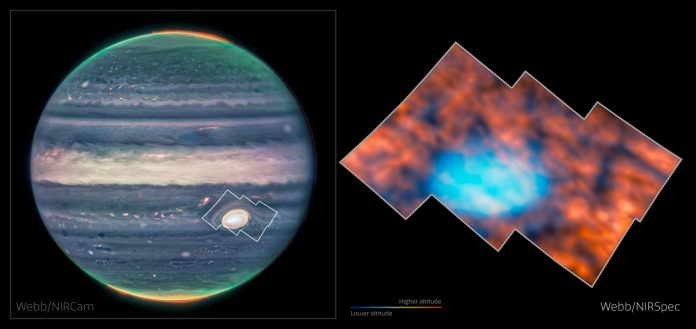
Using the powerful NASA/ESA/CSA James Webb Space Telescope, scientists have made unexpected discoveries in Jupiter’s upper atmosphere, particularly in the region above the planet’s famous Great Red Spot.
This area, once thought to be dull and unremarkable, has revealed a variety of intricate structures and activities.
Jupiter is one of the brightest objects in the night sky and can be easily seen on a clear night.
While the planet’s bright northern and southern lights, known as auroras, are visible at the polar regions, the glow from Jupiter’s upper atmosphere is usually too weak for ground-based telescopes to see in detail.
However, Webb’s infrared sensitivity allows scientists to study this upper atmosphere with unprecedented clarity.
The upper atmosphere of Jupiter is where the planet’s magnetic field meets its lower atmosphere. In this region, spectacular auroras are fueled by volcanic material from Jupiter’s moon, Io.
But closer to the equator, the upper atmosphere is influenced mainly by sunlight.
Since Jupiter receives only 4% of the sunlight that Earth does, astronomers expected this equatorial region to be relatively uniform and uninteresting.
In July 2022, the James Webb Space Telescope used its Near-InfraRed Spectrograph (NIRSpec) to observe the Great Red Spot.
The team aimed to investigate if this region was truly as boring as they had predicted.
Surprisingly, the observations revealed a complex and active area with dark arcs and bright spots throughout the field of view. These findings were published in the journal Nature Astronomy.
“We thought this region would be really boring,” said Henrik Melin, the team leader from the University of Leicester in the United Kingdom. “It is just as interesting as the northern lights, if not more so. Jupiter never ceases to surprise.”
The light emitted from this region is driven by sunlight, but the team suggests that another mechanism must be altering the structure of the upper atmosphere.
One possible explanation is the presence of gravity waves, similar to waves crashing on a beach and creating ripples in the sand.
These waves are generated deep in Jupiter’s turbulent lower atmosphere, around the Great Red Spot, and travel upwards, changing the structure and emissions of the upper atmosphere.
Gravity waves can also be observed on Earth, but they are much weaker than those seen on Jupiter by Webb.
The team hopes to conduct more observations of these intricate wave patterns to understand how they move within Jupiter’s upper atmosphere and to learn more about the energy dynamics of this region.
The new observations showed that the upper atmosphere hosts a variety of intricate structures, including dark arcs and bright spots.
The NIRSpec instrument captured images showing infrared light emitted by hydrogen molecules in Jupiter’s ionosphere, which lies over 300 km above the storm clouds of the Great Red Spot.
In these images, red colors indicate hydrogen emission from high altitudes, while blue colors show infrared light from lower altitudes, including the cloud-tops and the Great Red Spot itself.
“One way to change this structure is by gravity waves,” explained Henrik Melin. “These waves are generated deep in the turbulent lower atmosphere and can travel up in altitude, altering the upper atmosphere’s structure and emissions.”
These findings are significant for the European Space Agency’s Jupiter Icy Moons Explorer (Juice), which launched on April 14, 2023. Juice will make detailed observations of Jupiter and its three large ocean-bearing moons—Ganymede, Callisto, and Europa. The mission aims to explore these moons as potential habitats, study Jupiter’s complex environment, and understand gas giants across the universe.
The observations were part of the Early Release Science program, which began in 2017. Team member Imke de Pater from the University of California, Berkeley, noted that one of their original goals was to investigate why the temperature above the Great Red Spot appeared high. However, the new data from Webb showed very different results.
Jupiter’s upper atmosphere, once thought to be uninteresting, has proven to be a dynamic and intriguing region, thanks to the groundbreaking capabilities of the James Webb Space Telescope.



